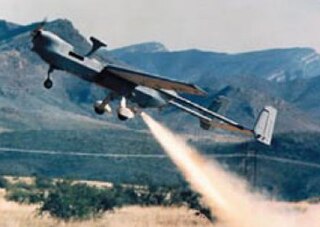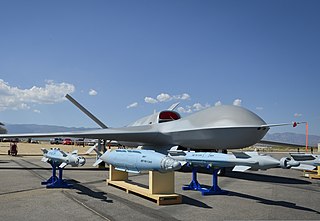Related Research Articles

The IAI RQ-5 Hunter unmanned aerial vehicle (UAV) was originally intended to serve as the United States Army's Short Range UAV system for division and corps commanders. It took off and landed on runways. It used a gimbaled EO/IR sensor to relay its video in real time via a second airborne Hunter over a C-band line-of-sight data link. The RQ-5 is based on the Hunter UAV that was developed by Israel Aerospace Industries.

The AAI RQ-7 Shadow is an American unmanned aerial vehicle (UAV) used by the United States Army, Australian Army, Swedish Army, Turkish Air Force and Italian Army for reconnaissance, surveillance, target acquisition and battle damage assessment. Launched from a trailer-mounted pneumatic catapult, it is recovered with the aid of arresting gear similar to jets on an aircraft carrier. Its gimbal-mounted, digitally stabilized, liquid nitrogen-cooled electro-optical/infrared (EO/IR) camera relays video in real time via a C-band line-of-sight data link to the ground control station (GCS).

An unmanned aerial vehicle (UAV), commonly known as a drone, is an aircraft without any human pilot, crew, or passengers on board. UAVs are a component of an unmanned aircraft system (UAS), which includes adding a ground-based controller and a system of communications with the UAV. The flight of UAVs may operate under remote control by a human operator, as remotely-piloted aircraft (RPA), or with various degrees of autonomy, such as autopilot assistance, up to fully autonomous aircraft that have no provision for human intervention.

Aerial photography is the taking of photographs from an aircraft or other airborne platforms. When taking motion pictures, it is also known as aerial videography.

A radio-controlled aircraft is a small flying machine that is controlled remotely by an operator on the ground using a hand-held radio transmitter. The transmitter continuously communicates with a receiver within the craft that sends signals to servomechanisms (servos) which move the control surfaces based on the position of joysticks on the transmitter. The control surfaces, in turn, directly affect the orientation of the plane.

The history of unmanned combat aerial vehicles (UCAVs) is closely tied to the general history of unmanned aerial vehicles (UAVs). While the technology dates back at least as far as the 1940s, common usage in live operations came in the 2000s. UCAVs have now become an important part of modern warfare, including in the Syrian civil war, the 2020 Nagorno-Karabakh war and during the 2022 Russian invasion of Ukraine.

The Boeing A160 Hummingbird is an unmanned aerial vehicle (UAV) helicopter. Its design incorporates many new technologies never before used in helicopters, allowing for greater endurance and altitude than any helicopter currently in operation.

The Northrop Grumman X-47B is a demonstration unmanned combat aerial vehicle (UCAV) designed for aircraft carrier-based operations. Developed by the American defense technology company Northrop Grumman, the X-47 project began as part of DARPA's J-UCAS program, and subsequently became part of the United States Navy's Unmanned Combat Air System Demonstration (UCAS-D) program. The X-47B is a tailless jet-powered blended-wing-body aircraft capable of semi-autonomous operation and aerial refueling.

The Elbit Hermes 450 is an Israeli medium-sized multi-payload unmanned aerial vehicle (UAV) designed for tactical long endurance missions. It has an endurance of over 20 hours, with a primary mission of reconnaissance, surveillance and communications relay. Payload options include electro-optical/infrared sensors, communications and electronic intelligence, synthetic-aperture radar/ground-moving target indication, electronic warfare, and hyperspectral sensors.

First-person view (FPV), also known as remote-person view (RPV), or simply video piloting, is a method used to control a radio-controlled vehicle from the driver or pilot's view point. Most commonly it is used to pilot a radio-controlled aircraft or other type of unmanned aerial vehicle (UAV). The vehicle is either driven or piloted remotely from a first-person perspective via an onboard camera, fed wirelessly to video FPV goggles or a video monitor. More sophisticated setups include a pan-and-tilt gimbaled camera controlled by a gyroscope sensor in the pilot's goggles and with dual onboard cameras, enabling a true stereoscopic view.

The Airbus Zephyr is a series of lightweight solar-powered unmanned aerial vehicles (UAV). The latest model is a high-altitude platform station capable of flying at 70,000 feet (21,000 m) for months at a time without fueling. It has a wingspan of 25 metres (82 ft) and weighs 75 kilograms (165 lb).

The Elbit Systems Skylark I and Skylark II are miniature UAVs developed by Elbit Systems.

The General Atomics MQ-20 Avenger is a developmental unmanned combat aerial vehicle built by General Atomics Aeronautical Systems for the U.S. military.

A delivery drone is an unmanned aerial vehicle (UAV) used to transport packages, medical supplies, food, or other goods. Delivery drones are typically autonomous. In November 2020 the FAA proposed airworthiness criteria for type certification of delivery drones with an intent to initialize commercial operations. Zipline, Wingcopter, and Amazon Prime Air were amongst the 10 companies selected for this type certification.
The US Federal Aviation Administration has adopted the name unmanned aircraft (UA) to describe aircraft systems without a flight crew on board. More common names include UAV, drone, remotely piloted vehicle (RPV), remotely piloted aircraft (RPA), and remotely operated aircraft (ROA). These "limited-size" unmanned aircraft flown in the USA's National Airspace System, flown solely for recreation and sport purposes, such as models, are generally flown under the voluntary safety standards of the Academy of Model Aeronautics, the United States' national aeromodeling organization. To operate a UA for non-recreational purposes in the United States, according to the FAA users must obtain a Certificate of Authorization (COA) to operate in national airspace. In December 2015 the FAA announced that all UAVs weighing more than 250 grams flown for any purpose must be registered with the FAA.

The use of unmanned aerial vehicles (UAVs) or Drones, is generally regulated by the civil aviation authority of the country. Nevertheless, the International Civil Aviation Organization (ICAO) began exploring the use of drone technology as far back as 2005, which resulted in a 2011 report. France was among the first countries to set a national framework based on this report and larger aviation bodies such as the FAA and the EASA quickly followed suit, which eventually led to influential regulations such as Part 107 and Regulation (EU) 2019/947. As of January 2022, several countries are working on new regulations, ranging from BVLOS operations to UTM activities, which include the US, the EU, India, South Korea, Japan, and Australia among others.

The Saegheh is an Iranian turbofan/piston-powered flying wing unmanned combat aerial vehicle (UCAV) produced by Shahed Aviation Industries. It is based on, but smaller than and substantially different from, a Lockheed Martin RQ-170 Sentinel UAV that was captured by Iran in 2011 and then reverse-engineered. It is one of two Iranian flying wing UAVs based on the RQ-170, along with the Shahed 171 Simorgh, a full-size copy.
According to the Civil Aviation Authority of Singapore (CAAS), an unmanned aircraft (UA), commonly known as a drone, is operated without a pilot on board. An unmanned aircraft system (UAS) comprises the UA and associated elements such as the remote control equipment.

Regulation of UAVs in the United Kingdom prescribes the rules that operators of unmanned aerial vehicles must follow in the UK.
References
- 1 2 3 4 5 6 "Operation of Unmanned Aircraft Systems in Irish Airspace". Irish Aviation Authority. Archived from the original on 4 January 2014. Retrieved 6 July 2013.
- ↑ "APPLICATION TO OPERATE AN UNMANNED AIRCRAFT SYSTEM". Irish Aviation Authority. Archived from the original on 5 January 2014. Retrieved 6 July 2013.
- ↑ "Irish Aviation Authority (Rockets and Small Aircraft) Order, 2000". Irish Aviation Authority . Retrieved 6 July 2013.
- ↑ "Registration Requirements for Remotely Piloted Aircraft (RPA)". Irish Aviation Authority. Archived from the original on 6 July 2013. Retrieved 6 July 2013.
- ↑ "Irish Aviation Authority (Nationality and Registration of Aircraft) Order, 2005". Irish Aviation Authority. Archived from the original on 4 January 2014. Retrieved 6 July 2013.
- 1 2 McMahon, Aine (12 July 2014). "Aviation body has issued 22 drone permits". The Irish Times . Retrieved 13 July 2014.
- 1 2 Ó Fátharta, Conall (18 December 2015). "1kg drones must be registered under new laws". Irish Examiner . Retrieved 27 December 2015.
- 1 2 McGreevy, Ronan (17 December 2015). "No more flying your drone over military bases from Monday". The Irish Times . Retrieved 27 December 2015.
- 1 2 3 4 5 6 7 "IRISH AVIATION AUTHORITY SMALL UNMANNED AIRCRAFT(DRONES) AND ROCKETS ORDER, 2015" (PDF).